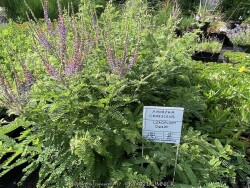
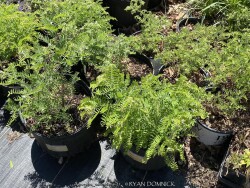
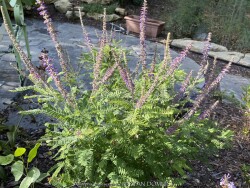
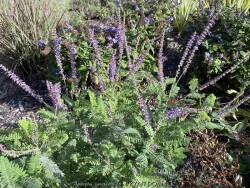
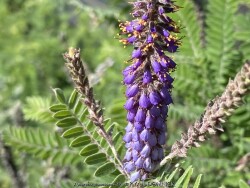
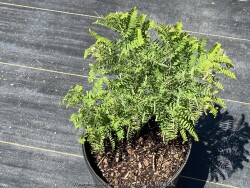
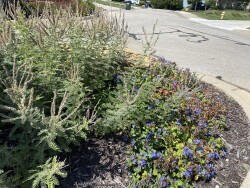
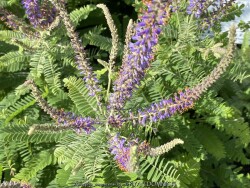

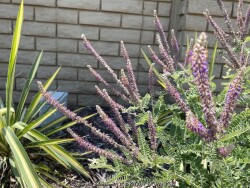
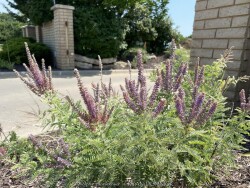
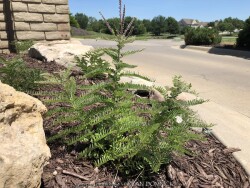
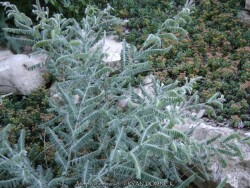
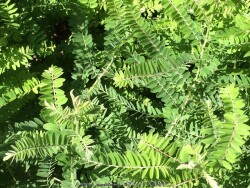
Plant Min Zone: 2b
Plant Max Zone: 9a
Sunlight: All Day Full Sun, Full Sun
Water / Rainfall: Very Low, Low
Soil Quality: Poor, Average
Bloom Season: Early Summer, Summer
Flower Color: Lavender
Berry / Fruit Color: Silver-Grey
Spring Foliage Color: Mint Green
Summer Foliage Color: Mint Green
Fall Foliage Color: Mint Green
Evergreen Foliage: No
Winter Interest: Yes
Scented Flowers: No
Drought Tolerance: High
Wet-Feet Tolerance: Low
Humidity Tolerance: Low, Medium
Wind Tolerance: High
Poor Soil Tolerance: Rocky Soils, Sandy Soils, Shallow Soils, Alkaline Soils (high PH)
Height: 1.5' - 2'
Width: 1.5' - 2'
Growth Rate: Slow
Service Life: Long: 5-10 years
Maintenance Need: Low
Spreading Potential: Extremely Low
Yearly Trimming Tips: Shrub Normally Winter-kills so trim to 6-12" off Ground in Winter or Early Spring: Blooms on New Wood.
Plant Grouping Size: Small Grouping of 3-5, Medium Grouping of 5-10
Best Side of House: South Exposure, West Exposure
Extreme Planting Locations: Survives Severe Drought, Tolerates Extreme Heat, Top of Retaining Wall Locations, Resistant to Rabbits
Ornamental Features: Multiple Seasons of Interest, Exceptional / Colorful Foliage
Special Landscape Uses: Naturalizing
Possible Pest Problems: Weed Competition, Root Rot Disease, Rabbits
Plant Limitations: Needs Excellent Drainage, Slow to Reach Mature Size, Late to Emerge or Leaf Out in Spring
Shippable in 2026: YES
Leadplant (Amorpha canescens) is a small, deciduous perennial semi-shrub, 1-3 ft. tall, with tiny, purple flowers grouped together in colorful, terminal spikes with orange pollen. The blooming season is relatively short but the pinnately compound leaves offers lasting interest and a "Wow" factor. Leadplant can be found in many locations throughout North America but mostly in the midwest USA. Disjunct populations also exist in Texas, New Mexico and Colorado but skipping the fire-prone areas of the Great Plains. Leadplant is typically found in dry prairie pockets of land that are not overgrown, do not burn frequently, and experience minimal live-stock grazing. Leadplant grows best in drier, well-drained soil of many different textures including sandy, gravely, and rocky soils. Leadplant needs full sun for flowering and to avoid floppiness. Mainly used in Kansas landscapes in native prairie gardens, it tolerates considerable drought and alkaline limestone clay soils. It does best on a berm with great drainage or un-irrigated parking lot islands and "hell-strips". Leadplant has only one pest problem and that is rabbits! If rabbits are an issue, just put a bowl-shaped chicken wire cage around the plants for the first year. By year #2, the rapidly growing foliage will outgrow any detrimental rabbit browsing. This is definitely one of the most adapted native landscape shrubs in Kansas zone 6a with no problems with heat, cold, or drought! It's hard to imagine a native perennial garden without this plant! Butterflies will thank you!